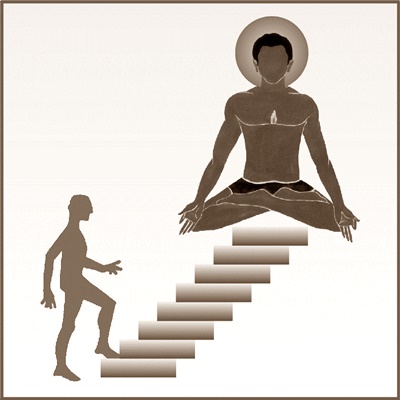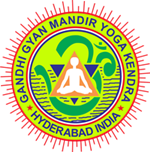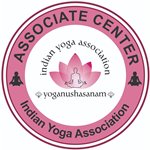- Introduction
- 1. YAM (Rules)
- 2. NIYAM (Regulations))
- 3. ASANAS (Postures)
- 4. PRANAYAAM (Control or extension of Pran–vital energy)
- 5. PRATYAHAR (Withdrawal of senses))
- 6. DHARANA (Concentration)
- 7. DHYAN (Meditation)
- 8. SAMADHI (Super-consciousness)

What is the aim of human life? Different people have answered this question in different ways. Apart from the idea of enjoying a luxurious life with pleasures and happiness, there is the concept of Dharma, Artha, Kama, Moksha… as the aim of life in our country from the ancient time. To achieve this aim, our ancestors have divided the human life into four stages. They are Brahmacharyashram (bachelor stage) Gruhasthashram (married life), Vana-prasthashram (retired life) and Sanyasashram (detachment from the worldly life). They preached us to lead the life accordingly. But we don’t find such an environment to follow those stages in these days.
Spirituality finds a prominent place in all the religions in this regard. The main aim of Yoga science is also the same. Our ancestors have defined Yoga as the union of Atma with Paramatma. This union is possible through Dhyan (meditation) and Samadhi (superconscious state). To reach such a state one should be able to resist the worldly attachments and control the mind and streamline the thought flow. That is why, Patanjali prescribed “Yogashchitta Vrutti Nirodhaha”. Our Rishis, Munis, Yogis have given much importance to practice Yoga following its prescribed rules. A Yoga practitioner can conveniently understand the importance of these rules. The main aim of Yoga education is to teach that one has to strive to understand the philosophy of Atma and Paramatma leading a worldly life. If one tries so practically, his life becomes worth living. To lead such a life human body is the prime means. There are two shapes to the human body.
1. The physical personality or the external shape
2. The abstract shape or the inner self
Patanjali Maharshi, keeping in view the then existing many Yoga systems and the body, mind, intellect, emotions, atma etc., had conducted many researches and evolved and suggested the eight steps / parts / aspects of Yoga.
यमनियमासनप्राणायामप्रत्याहारधारणाध्यानसमाधयोऽष्टावङानि । (पतंजलि)
They are:
* Yam * Niyam * Asan * Pranayaam * * Pratyahar * Dharana * Dhyan * Samadhi *
Yam, Niyam, Asan and Pranayaam have greater effect on the physical personality or external shape of the individual. These four together are called Bahirang Yoga.
Pratyahar, Dharana, Dhyan and Samadhi have greater effect on the internal personality of the individual. They are called interior Yoga steps, or Antarang Yoga.
It is necessary for every one to know about these eight steps.
1. YAM (Rules):
Yam means the universally approved code of social conduct.
This is the first aspect of Yoga. There were a number of yamas in the ancient period. Patanjali Maharshi had selected only five from among them. They are : Ahimsa, Satya, Asteya, Bramhacharya and Aparigraha. They are concerned mainly with social behavior. The main purpose of these yamas is to guide the man to behave in a socially approved way.
a. Ahimsa (Non-violence):
To refrain from causing harm either mentally, orally or physically to any other living being. All living beings are to be protected by thought, word and deed. Neither one should encourage the violence nor stimulate any one to do so.
b. Satya (Truth):
To be truthful in thought, word and deed and to refrain from speaking untrue.
c. Asteya (Non-stealing):
To refrain from theft, corruption, black marketing, adulteration and other anti social activities. Neither to encourage those who indulge in them nor stimulate any one to act so.
d. Brahmacharya (Celibacy):
To behave properly by fully controlling the five sense organs, five working organs and the mind so as to lead a balanced life, and to have proper control on sexual behaviours.
e. Aparigraha (Non-hoarding):
Not to procure or accumulate the material, more than the required and strive for the well being of others.
2. NIYAM (Regulations):
Niyam is a set of rules to purify the self through the code of personal conduct.
They are concerned with the spiritual development. From among many niyamas Patanjali Maharshi had taught the five selected ones. They are: Shauch, Santosh, Tap, Swadhyay and Ishwara pranidhaan.
a. Shauch (Cleanliness):
To be clean by body and mind. Every one takes bath to keep the body clean. One has to keep the house, surroundings, work place and the clothes clean. For internal cleanliness, one can remove the internal impurities of the body through the six prescribed Yogic cleaning activities. Thus, one can be pure internally and externally. One should be pure in thought, word and deed also.
b. Santosh (Happiness):
Happiness provides with half of the required strength of a man. If one is satisfied with whatever he gets, he may lead a happy and pleasurable life. It is very difficult to be contented with whatever one gets in this materialistic world, still one can lead so with a strong will…
c. Tap (Penance):
To face the difficulties with patience and to keep the body and mind peaceful. It increases the inner power to work harder.
d. Swadhyay (Self study):
To acquire the knowledge of the Self by studying literary and spiritual scriptures and to know it, Satsang (listening to discourses) is a must. Also one must always try to be in company of people who can guide and create good thoughts.
e. Ishwara pranidhaan (Total surrender to Divine):
To practice and make it a habit to surrender oneself to the God and do the activities. One has to give up his ego and offer the result of the work to the God. One has to serve the society without any expectations.
The Yamas and the Niyamas are the life styles. People observed them and made the Yamas and Niyamas as their way of life in the ancient period, that is why we call it a Golden era. Let us all also try to observe them as far as possible and make the society a place of happiness, peace and tranquility.
3. ASANAS (Postures):
Asan means a posture. There are many asanas. These are popular with the term of Yogasanas. Asanas are an important component of Yoga science. Asanas are the means to clean the body, to develop the limbs and organs and to increase the life span. We get the strength and power to fight the disease-causing elements by practicing asanas.
“Sthiram Sukham Asanam”, commented Patanjali. It means to be in a state of a posture with ease and without any movement for a while. Generally one cannot be in a state of a posture without any movement for a long time. We all have the experience in a photo studio, where the photographer many times requests us not to move and to be in his prescribed pose. How difficult it is to be in a single pose even for some time? To develop this skill, certain dynamic asanas have been developed to keep the limbs and other parts of the body in different positions, to move and bend them easily and conveniently. The main aim of these asanas is to develop the efficiency of the functioning of different parts and organs of the body and to energise them. According to one’s own capacity one has to practice asanas with concentration, without any haste or hurry and prepare himself to enter the higher stages of Yoga.
4. PRANAYAAM (Control or extension of Pran–vital energy):
Pranayaam is the process of controlling the breath with a rhythm. Pranayaam is a compound word with Pran and Ayam. Pran means the power to life that is breathing. Ayam means to develop or increase. Thus Pranayaam may be defined as an exercise to increase or control the power of life. There are many methods of Pranayaam.
“Pranayaamen Yukten Sarva Rog Kshyay Bhavet-” it is said. It means, Pranayaam, if practiced systamatically, can cure all diseases. If we practice Pranayaam correctly and properly, our health and mind are always in our control. Pranayaam is also known as gateway to meditation.
5. PRATYAHAR (Withdrawal of senses):
Pratyahar is the state of mind, free from the influence of sense organs.
Pratyahar means pacifying the mind or thoughts, heart or feelings for keeping the mind in a subtle state without any thoughts. If our mind reaches such a state, our organs are under our control. Mind acquires the efficiency of concentration and thereby one easily can proceed towards higher levels.
6. DHARANA (Concentration):
Dharana is concentration of mind.
Dharana means concentrating the mind on a single aspect or an object or a subject, like one’s favourite deity or a symbol or a mantra or the minute aspects or spots such as center of the eye brows, tip of the nose, heart, navel etc. Practitioners can increase their power of concentration or Dharana by modifying their daily routines, behavior, food, relaxation etc.
7. DHYAN (Meditation):
Dhyan is state of meditation.
Dhyan means to deeply concentrate the mind and heart on a single point. It has vital importance. Different methods of Dhyan are in practice in different parts of the world.
8. SAMADHI (Super-consciousness):
Samadhi is a state of super consciousness and self realisation.
Overcoming the hurdles and interruptions and concentrating the mind and heart and immersing the Self in that tranquility is called Samadhi. The peak of the Dhyan is Samadhi. In Dhyan state:
a) Dhyan
b) the practitioner of Dhyan and
c) the aspect of Dhyan. These three are different. But in Samadhi these three are united together. Realizing the Atma and the union of Atma with Paramatma is the main aim of Samadhi. It is the supreme Yoga.
![]()
The above eight aspects of Yoga are boons blessed to the world by the ancient Indian culture. Everyone has to know and practice them.
वपुः कृशत्वं, वदने प्रसन्नता, नाद-स्फुटत्वं, नयने सुनिर्मले,
अरोगता, बिन्दुजयम्, अग्निदीपनं, नाडी विशुद्धिर्हठसिद्धि लक्षणम् ।
Slim-Trim body, happy & shining face, clear voice, sparkling eyes, free from all diseases, controlled sense organs, perfect digestion and pure nervous system are the basic qualities of a Yogi. – Hath Yog Pradeepika
![]()

